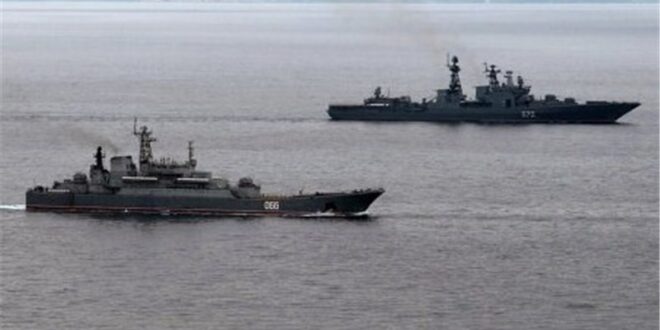Russian Threat in the Baltic Sea
(FPRI) — The current strategic focus of the United States centers around how to confront the challenges presented by this new era of Great Power competition. As the United States shifts its focus on China and pivots to the Pacific, it must find a way to fulfill its commitments to allies in other areas of the world. The United States European Command (EUCOM), in concert with the North Atlantic Treaty Organization (NATO), are the main institutions positioned to protect Europe. EUCOM and NATO have been given the difficult task of confronting a resurgent and aggressive Russia. Russia has used a variety of gray-zone initiatives to reduce NATO capability and response in areas of Russian interest. Russia has shown in recent conflicts that it will be the aggressor and will deploy asymmetric capabilities to reduce the defensive capacity of targeted nations.[1] By exercising gray-zone warfare in places like the Crimean Peninsula, Russia has been able to seize the initiative.[2] Such tactics have allowed for the expansion of Russian influence without incurring direct intervention from NATO. By exercising similar initiative and use of gray-zone power in the Baltic Sea region, Russia could further expand its influence over former Soviet republics.
Russia will continue to use gray-zone initiatives such as cyber and information to increase its influence and to weaken and divide nations in the Baltic. In addition to the newer and more novel means of gray-zone power, Russia maintains a robust and highly capable stockpile of mines.[3] Russia can use this more traditional mine threat asymmetrically to complement its other gray-zone initiatives in the Baltic and to help assert its dominance. Therefore, NATO must understand the potential for Russian mines to destabilize the Baltic and should be prepared to rapidly counter this threat in order to provide regional security. First, NATO must realize Russian use of mines could cause severe energy and economic impacts to the Baltic region. Second, mining in the Baltic would also weaken and destabilize the NATO alliance. Finally, NATO must pursue effective means of rapidly minimizing the impact of Russian mining in the Baltic.
Russian Use of Gray-Zone Warfare
Russia has invested in gray-zone warfare as a means of leveling the playing field against its adversaries. The fall of the Soviet Union left Russia a significantly weaker state, losing portions of its former territory and military capacity.[4] Under Putin, Russia began to rebuild its armed forces so that it could better support Russian national security strategies.[5] Despite this increase in defense spending, Russia could not match the power of combined NATO forces. A new strategy had to be employed to give Russia a competitive edge over its adversaries. The proliferation of the internet and social media provided Russia the opportunity it needed. The use of extensive information campaigns and cyberattacks has been able to weaken and destabilize Russian areas of interest.[6] Russia has grown in influence and expanded its claimed territory at the expense of Georgia and Ukraine. By engaging in hybrid warfare, Russia has been able to effectively combine the use of military resources with gray-zone warfare to generate a resurgent Russia.
Russia has made extensive use of gray-zone power under Putin in its quest to regain influence in Europe. One of the defining aspects of gray-zone warfare is that its effects remain below a level that would warrant a direct military recourse from NATO.[7] Russia has used information campaigns, cyberattacks, sanctions, and energy measures to help shape its influence in nations previously dominated by the Soviet Union.[8] Although these are some of the more prevalent and visible methods Russia uses, it regularly employs a variety of other gray-zone initiatives.
Russia has been successful at using gray-zone warfare to enhance its influence and territory. In Georgia, Russia instituted a widespread information campaign, along with cyberattacks and energy coercion, to assert its control over the breakaway provinces of Abkhazia and South Ossetia while diminishing the ability of the Georgian government or NATO to effectively respond.[9] Among other measures in Ukraine, Russia employed a substantial disinformation campaign along with unmarked irregular forces to weaken Ukrainian control in Crimea and to eventually justify the Russian annexation of the Crimean peninsula in 2014.[10] Beyond these two Russian victories, Putin is actively trying to subvert areas in the Baltic. One example of Russian interference in the Baltic region is Russia’s use of disinformation to sow discord in Poland, combined with Polish dependence on Russian energy exports.[11] Russia continues to leverage gray-zone initiatives in areas it considers of national importance. Following its success in gray-zone tactics around the Black Sea, Russia has begun to heavily assert its revisionist and expansionist agenda in the Baltic.
NATO has not been able to formulate an effective way to deal with Russia’s asymmetric threat. NATO and Western culture view war and peace as separate entities and find it difficult to classify areas that ambiguously fall in the middle.[12] Because of Russian gray-zone manipulation, “Western strategy and policy communities struggle to respond in a coordinated manner to hostile measures.”[13] Russian activities have been able to remain at a level below which NATO has been willing to engage, allowing Russia to perpetuate its use of gray-zone power across Europe. The use of mines as a form of gray-zone warfare is in line with other Russian initiatives. By cloaking the use of mines behind a disinformation campaign and the necessity to protect Baltic energy supplies, Russia could provide a legal justification for mine use, resulting in a limited or a negligible response from NATO.
Energy and Economics in Baltic Sea Mine Warfare
NATO must realize Russian use of mines could cause severe energy and economic impacts to the Baltic region. Energy coercion is one of Russia’s primary means of exercising gray-zone power. The Baltic region accounts for over 40 percent of all Russian energy exports.[14] Russian use of mines to protect their energy resources and induce energy coercion in the region would cause severe energy and economic impacts to affected Baltic nations.
Russia can use the pretense of protecting its energy interests and transit routes to justify the use of mines in the Baltic. It can employ a variety of energy coercion methods by employing mines generated through the pretext of its energy export security requirements, as Russia has tasked its navy with protecting the pipelines.[15] The Russian Navy is known to routinely operate in other nations’ exclusive economic zones and to interfere with the civilian and military maritime activities of countries.[16] Russia has previously used military exercises as a pretense to exact energy coercion, as demonstrated by its interference with the laying of the NordBalt power cable.[17] The threat or use of mines by Russia would be in line with previous Russian gray-zone initiatives in both the Black and Baltic seas. Just the threat of mining in the Baltic would cause significant energy and economic impacts to the region. Taking a more protectionist position, Russia could also use traditional military vessels to mine areas to secure pipelines and energy interests in the Baltic. More in line with gray-zone initiatives, Russia could utilize normal commercial or fishing routes to lay mines from nontraditional vessels, labeling them as “rogue elements” within the Baltic region.[18] Implementing any of these methods of mining will threaten the energy security of Baltic nations and enhance regional destabilization.
Russia could use mines as a form of energy coercion against the Eastern Baltic region. These countries rely heavily on imported energy. Although much of the Baltic energy supply comes from Russia, Baltic countries have increased imports from Norway to help minimize Russian dependency.[19] Because these imports come via tanker ships, they are highly susceptible to mining. Seaborne energy transit to Baltic nations will be brutally impacted by any mine threat in the region. Due to the volatility of their cargo and the extreme expense of insuring vessels through hazardous areas, any mining that targets an Eastern Baltic nation will have a crippling effect on seaborne energy imports. Russia can make substantial gains while disrupting and eroding societal resistance to Russian aggression through the mining of Baltic energy infrastructure.[20] By combining the pressure caused by decreased energy imports with other gray-zone initiatives, Russia can destabilize nations in the Baltic and grow its influence in the region.
NATO Impacts
Russian use of mines in the Baltic can weaken and destabilize the NATO alliance, allowing additional Russian influence in former Soviet republics and across Europe. By waging a continual gray-zone campaign against NATO’s Baltic countries, Russia is sowing discord among member states.[21] By incorporating mines into its gray-zone repertoire, Russia could deliver an asymmetric threat that could cause great harm to NATO members. Russia is placing NATO’s Baltic region under increasing pressure.
Despite the danger of Russian mining of the Baltic to NATO members, some would argue that it is not an issue that NATO can spend its time on. There are several significant issues that NATO is currently dealing with, and mining of the Baltic is not high enough on the priority list. NATO must deal with the more immediate concerns of its members, such as the fear of terrorism, immigration issues, and the more conventional land-based Russian threat. This argument would point out that Russian mining would be an overt act of war and immediately invoke NATO’s Article 5 if it were implemented.[22] Because mining is unlikely, NATO should instead concern its efforts on the more visible threats to its member nations.
However, Russia is not likely to view the use of mines with the same prohibition that its Western competitors do. Russia is known to maintain the largest sea mine stockpile of any nation — approximately 250,000 munitions.[23] The Hague Convention VIII that forms the basis for legal use of mines is not signed by Russia, and the wording is vague, allowing for a variety of interpretations.[24] Based on Russia’s use of gray-zone warfare, a more liberal interpretation that allows for the use of mines to protect its energy exports is likely. Russia has also proven its willingness to use mines during the Ukrainian conflict in the Sea of Azov.[25] Since annexing Crimea, Russia has modernized its mine inventory and increased sea mine production.[26] This demonstrated Russian history of mine use in the Black Sea region, increased mine production, and limited inhibition on the deployment of mines greatly increases the potential use of mines in the Baltic as a gray-zone threat.
The NATO alliance will be greatly strained by any use of mines in the Baltic Sea. The Baltic region is host to multiple NATO members, all of which rely on energy imports from the Baltic Sea. Russia can test the credibility of NATO by selectively threatening the placement of mines—or deploying them—against a NATO member state using the guise of protecting Russian energy interests. For NATO to act against Russia and invoke Article 5, it would take all members to vote in favor of action. German polls have shown in the past that over half the population favors not supporting NATO allies in a conflict against Russia — one example of how solidarity may be difficult to achieve.[27] By deploying mines in their gray-zone campaign, Russia can exploit any NATO fractures to its benefit, reducing the credibility of the NATO alliance to members and aspirant nations.
Mitigating the Threat
NATO cannot allow the usage of sea mines as another form of gray-zone power in the Baltic. Russian use of mines in the Baltic could rapidly destabilize Baltic nations, allowing for growth in Russia’s influence and possible territorial gains. Traditional Western methods of deterrence have failed to stop continuing Russian aggression in the Baltic. NATO countries have imposed severe economic sanctions against Russia and taken other conventional actions that have failed to deter Russia. NATO must pursue effective means of providing security for its Baltic members by rapidly minimizing the potential impact of Russian gray-zone mining.
NATO must be prepared to meet the Russian gray-zone threat of mining with a hybrid of traditional and unconventional methods. Although NATO maintains Standing NATO Mine Countermeasures Group One as a deterrent for mines, and individual nations have invested in mine countermeasure platforms, they are not currently an effective deterrent.[28] Mine clearance platforms require an uncontested environment in which to operate. Given the expected gray-zone deployment of these mines, NATO could encounter Russian resistance to clearance attempts. NATO must develop tactics, techniques, and procedures to employ current and future mine countermeasure forces into contested environments and must increase mine clearance capacity in order to rapidly clear mined areas. EUCOM and NATO must also explore gray-zone initiatives of their own to deter Russian mining in the Baltic. EUCOM and NATO must make clear to Russia that allied gray-zone initiatives will be used against Russia in the event of Russian mining. Such measures could include deployment of NATO mines to impede Russian operations, unspecified cyberattacks against Russia, limitations on the use of the dollar and Euro, or the funding and construction of alternate energy pathways. Regardless of the specific measures selected, NATO must ensure it combines moves beyond the binary Western view of peace and war. NATO needs to develop gray-zone capabilities that can effectively act as a deterrent to prevent Russian deployment of mines, combined with more robust conventional mine countermeasure units capable of operating in contested environments.
Conclusion
NATO’s Baltic members are under constant threat by Russian gray-zone initiatives. Russia has used its asymmetric power to weaken and destabilize nations like Georgia and Ukraine, increasing its territory and influence in Europe. The potential use of Russian mines in the Baltic allows Russia to exercise energy and economic coercion that can cause significant impacts to NATO member nations throughout the Baltic region. Mining of the Baltic region could test the credibility of the NATO alliance, weakening it in the eyes of members and aspirant nations. To counter and deter the Russian mine threat, NATO must pursue a combination of conventional and gray-zone initiatives. For NATO to be successful in countering Russia, it needs to broaden its perspective on what constitutes hostilities and be prepared to defend against the gray-zone warfare that Russia is already using against its member nations.
 Eurasia Press & News
Eurasia Press & News




